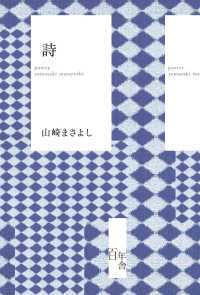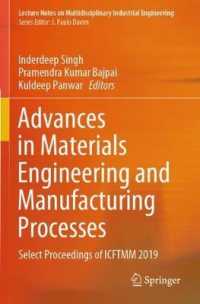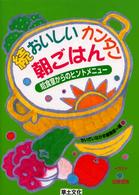- ホーム
- > 洋書
- > 英文書
- > Science / Mathematics
基本説明
2009年春季第56回応用物理学関係連合講演会(筑波大)好評書。
Describes a wide range of materials and applications that are of current interest including organic light emitting materials and devices, inorganic light emitting diode materials and devices, down-conversion materials, nanomaterials, and powder and thin-film electroluminescent phosphor materials and devices.
Full Description
Luminescence, for example, as fluorescence, bioluminescence, and phosphorescence, can result from chemical changes, electrical energy, subatomic motions, reactions in crystals, or stimulation of an atomic system. This subject continues to have a major technological role for humankind in the form of applications such as organic and inorganic light emitters for flat panel and flexible displays such as plasma displays, LCD displays, and OLED displays. Luminescent Materials and Applications describes a wide range of materials and applications that are of current interest including organic light emitting materials and devices, inorganic light emitting diode materials and devices, down-conversion materials, nanomaterials, and powder and thin-film electroluminescent phosphor materials and devices. In addition, both the physics and the materials aspects of the field of solid-state luminescence are presented. Thus, the book may be used as a reference to gain an understanding of various types and mechanisms of luminescence and of the implementation of luminescence into practical devices.
The book is aimed at postgraduate students (physicists, electrical engineers, chemical engineers, materials scientists, and engineers) and researchers in industry, for example, at lighting and display companies and academia involved in studying conduction in solids and electronic materials. It will also provide an excellent starting point for all scientists interested in luminescent materials. Finally it is hoped that this book will not only educate, but also stimulate further progress in this rapidly evolving field.
Contents
Series Preface. Preface. 1 Principles of Luminescence (Adrian H. Kitai). 1.1 Introduction. 1.2 Radiation Theory. 1.3 Simple Harmonic Radiator. 1.4 Quantum Description. 1.5 Selection Rules. 1.6 Einstein Coefficients. 1.7 Harmonic Perturbation. 1.8 Blackbody Radiation. 1.9 Dipole-Dipole Energy Transfer. 1.10 Energy Levels in Atoms. 1.11 Crystal Field Splitting. Acknowledgement. References. 2 Phosphor Quantum Dots (Debasis Bera, Lei Qian and Paul H. Holloway). 2.1 Introduction. 2.2 Nanostructured Materials. 2.3 Quantum Dots. 2.4 Relaxation Processes of Excitons. 2.5 Blinking Effect. 2.6 Surface Passivation. 2.7 Synthesis Processes. 2.8 Optical Properties and Applications. 2.9 Perspective. Acknowledgement. References. 3 Color Conversion Phosphors for LEDS (Jack Silver and Robert Withnall). 3.1 Introduction. 3.2 Disadvantages of using LEDs without Color Conversion Phosphors. 3.3 Phosphors for Converting the Color of Light Emitted by LEDs. 3.4 Survey of the Synthesis and Properties of some Currently Available Color Conversion Phosphors. 3.5 Multi-Phosphor pcLEDs. 3.6 Quantum Dots. 3.7 Conclusions. Acknowledgements. References. 4 Development of White OLED Technology for Application in Full-Color Displays and Solid-State Lighting (T. K. Hatwar and Jeff Spindler). 4.1 Introduction. 4.2 Generation of White Light. 4.3 White OLEDs for Display Applications. 4.4 White OLED Tandem Architecture. 4.5 White OLEDs Based on Triplets. 4.6 White OLEDs Based on Conjugated Polymers. 4.7 White OLEDs for Solid-State Lighting. 4.8 Advanced Manufacturing of Large-Area Coatings. 4.9 Future Outlook. Acknowledgements. References. 5 Polymer Light-Emitting Electrochemical Cells (Jun Gao). 5.1 Introduction. 5.2 LEC Operating Mechanism and Device Characteristics. 5.3 LEC Materials. 5.4 Frozen-Junction LECs. 5.5 Planar LECs. 5.6 Conclusions and Outlook. References. 6 LED Materials and Devices (Tsunemasa Taguchi). 6.1 Introduction. 6.2 LED Structures and Effi ciencies. 6.3 Typical LEDs and Features. 6.4 Generation of White Light. 6.5 Devices and Applications. 6.6 Future Prospects. 6.7 Conclusions. References. 7 Thin Film Electroluminescence (Adrian H. Kitai). 7.1 Introduction. 7.2 Background of EL. 7.2.4 Sphere-supported thin film EL. 7.3 Theory of Operation. 7.4 Electroluminescent Phosphors. 7.5 Device Structures. 7.6 EL Phosphor Thin Film Growth. 7.7 Full-Color Electroluminescence. 7.8 Conclusions. References. 8 AC Powder Electroluminescence (Feng Chen and Yingwei Xiang). 8.1 Background. 8.2 Structure and Materials of AC Powder EL Devices. 6 LED Materials and Devices (Tsunemasa Taguchi). 6.1 Introduction. 6.2 LED Structures and Effi ciencies. 6.3 Typical LEDs and Features. 6.4 Generation of White Light. 6.5 Devices and Applications. 6.6 Future Prospects. 6.7 Conclusions. References. 7 Thin Film Electroluminescence (Adrian H. Kitai). 7.1 Introduction. 7.2 Background of EL. 7.3 Theory of Operation. 7.4 Electroluminescent Phosphors. 7.5 Device Structures. 7.6 EL Phosphor Thin Film Growth. 7.7 Full-Color Electroluminescence. 7.8 Conclusions. References. 8 AC Powder Electroluminescence (Feng Chen and Yingwei Xiang). 8.1 Background. 8.2 Structure and Materials of AC Powder EL Devices. 8.3 The Mechanism of Light Emission for AC ZnS-Powder-EL Device. 8.4 EL Characteristics of AC Powder EL Materials. 8.5 Preparation of Powder EL materials. 8.6 Limitations of AC Powder EL Devices. 8.7 Applications of ACPEL. References. Index.








